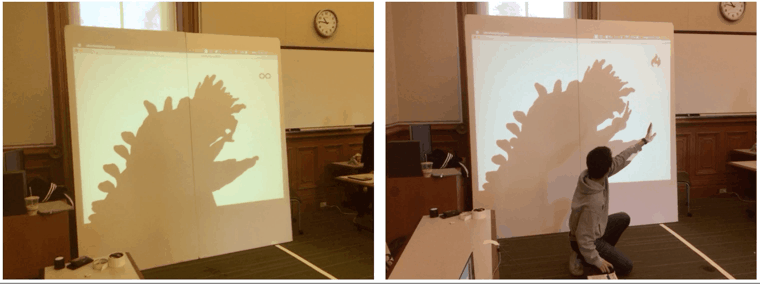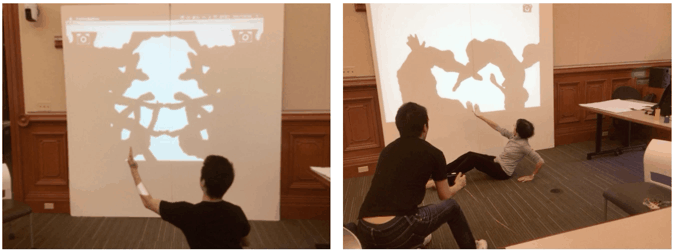 engaged guests during showcase
engaged guests during showcase
Shadow casting possess different physical affordances that follow the laws of physics. Different shadow shapes and patterns can be created by manipulating the shadow’s light source direction and intensity, the physical object’s distance and angle, and the texture of the surface in which the shadow is casted. These physical properties can be used by the operator to create creative patterns with the projected shadows. Some of these physical affordances include playing with the shadow’s movement, superposing different object’s shadows and scaling the shadow’s size by moving the physical object closer or further from the light source. As aesthetically pleasing with its unique black and white contrast, shadows are a fascinating form of media that can create different textures and details based on the skill of the user.
Shadow Play aims to enhance such a playful shadow experience to more advanced creative form of art by allowing users digitally manipulate their shadows. By adding new digital affordances Shadow Play, users can print and add layers of multiple shadows onto the screen, and invigorate them with animated effects and motions. With such various mix of augmented shadow effects, users can utilize their body as a tool for creating their own unique shadow artwork and animations.
See full paper
Summary of interaction:
Input/Output: Shadow Play requires ample activity space for interaction. The system recognizes the user within the activity space, and then displays the digitally augmented shadow onto the projected screen. Optimizing the interaction was one of our key concerns. With camera as an input device for users to communicate with Shadow Play, we wanted to depict the metaphor of users taking pictures and filming the creation. By selecting different features, such as snapshot, mirror, effects, and loop, users can create unique patterns and artwork. 
Interaction:
1. Setting the environment: With the shoot feature, users can add layers of current shadows to the previous ones. Users can create static shadows, in which we refer to as background/environment of the artwork. 
2. Adding in motion and effects: After the environment has been set, users can enliven the shadow by adding in animated motions and effects. The loop feature, mainly inspired by Instagram, records the motion of shadows and then is automatically looped. By adding in the fireball effect, Shadow Play recognizes the hand motion of reaching out, which then shoots out a fireball from the tip of the hand. 
3. Advanced: Mirror and Patterns: The mirror feature allows users to create symmetrical images and animation. The mirror feature is especially useful for creating patterns and symmetrical image, such as butterfly. 
With the mix of these features, users can create shadow artwork in playful environment. Shadow Play resembles the thought process and planning of an actual painting. Just as an artist would plan ahead where certain objects would be placed within the space before making the strokes, Shadow Play users have to deliberately organize the angle and distance of their body in order to perfect the layers of shadow into a single object shape. Such deliberation allows for more playful and interactive activity. By having the augmented shadows displayed on the screen, there is a loop of feedback and manipulation as users constantly refer to the captured shadow to make adjustments accordingly.”